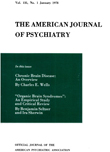VAGOTOMY—FIVE YEARS LATER
Abstract
On an average of 5 years after complete vagotomy, 24 of 25 peptic ulcer patients had no physical recurrence; 6, or 64%, of all men, achieved an excellent functional result with improved vigor, amiability, and total adjustment. No new psychiatric morbidity of any type has appeared in these patients.
Eight, or 32%, 3 of whom were women, while anatomically cured, are dissatisfied with vagotomy, maladjusted, and incapacitated by hypochondriasis, other psychosomatic disorder, or working under duress.
Study indicates that the patient who will probably get a good functional result from vagotomy can be psychiatrically identified prior to surgery. Suggested criteria for the identification of those who may get a poor functional result are also presented. This does not mean that these cases should not be operated upon if the accomplishment of an anatomical result is deemed of sufficient importance.
In addition to the individuals who accept their dependency and those who present reaction formation, there would appear to be a third group, namely, those who are independent at work and dependent at home.
In peptic ulcer patients with satisfactory reaction formation, it seems that some characteristics previously considered a part of the patient's personality are really pathoneurotic reactions to frustration of neurotic equilibrium and that they will vanish with successful vagotomy.
Intensive study of individual cases of functional success and failure after vagotomy will amplify our understanding of the psychodynamics involved and improve our ability to assist the surgeon in selecting cases.
Access content
To read the fulltext, please use one of the options below to sign in or purchase access.- Personal login
- Institutional Login
- Sign in via OpenAthens
- Register for access
-
Please login/register if you wish to pair your device and check access availability.
Not a subscriber?
PsychiatryOnline subscription options offer access to the DSM-5 library, books, journals, CME, and patient resources. This all-in-one virtual library provides psychiatrists and mental health professionals with key resources for diagnosis, treatment, research, and professional development.
Need more help? PsychiatryOnline Customer Service may be reached by emailing [email protected] or by calling 800-368-5777 (in the U.S.) or 703-907-7322 (outside the U.S.).



